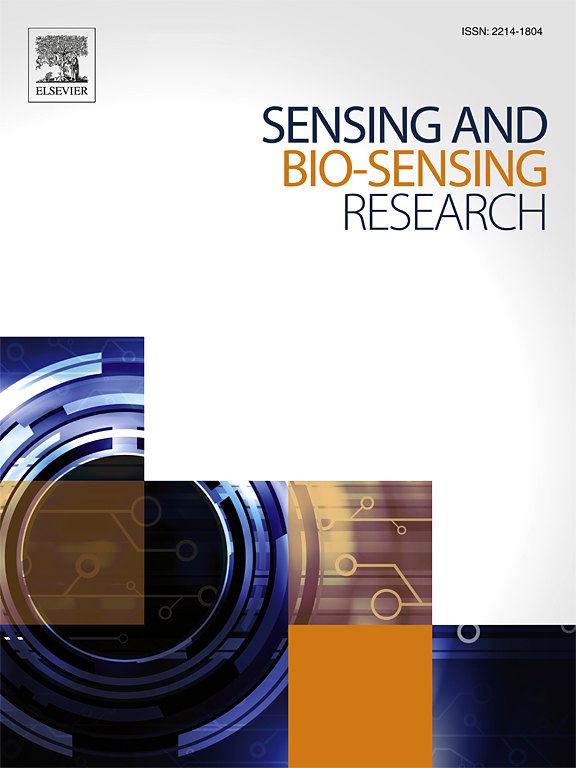液晶模板辅助电沉积纳米多孔镍微球:电催化氧化和左旋肉碱定量测定的灵敏电化学传感平台
IF 5.4
Q1 CHEMISTRY, ANALYTICAL
引用次数: 0
摘要
左旋肉碱(l-carnitine, LC)是哺乳动物组织的重要组成部分,在不同生物系统的功能中具有重要作用,其测定具有重要意义。利用镍质纳米结构电催化剂进行电化学传感具有潜在的研究方向和优势。在本研究中,电沉积纳米多孔镍微球(NNiMs),并将其作为电极改性剂用于电催化氧化和测定LC。在恒电位条件下,在含有氯化镍和Triton X-100的液晶介质上电沉积nnim。采用场发射扫描电镜对制备的纳米多孔微球进行了表面形貌表征。通过在碱性介质中连续施加电位循环将nnim转化为相应的氧化物,计算出修饰电极表面氧化还原物质的电子转移系数和表观电荷转移速率常数分别为0.59和0.54 s−1。采用循环伏安法、计时安培法和稳态极化法研究了LC在NNiMs表面的电催化氧化机理和动力学。实验结果表明,液相色谱扩散系数为4.1 × 10−6 cm2 s−1,催化速率常数为4.0 × 104 cm3 mol−1 s−1,电子传递系数为0.41。该传感器线性动态范围为25 ~ 217 μmol L−1,校准灵敏度为67.85 mA L mol−1,检出限为3.2 μmol L−1。所设计的传感平台具有稳定的可重复性,且不受生物液体和药物制剂中常见物种的干扰。综合上述特点,本方法可作为一种简便、快速的直接分析药物口服溶液和人血清样品中LC的工具。本文章由计算机程序翻译,如有差异,请以英文原文为准。
Liquid crystal template-assisted electrodeposition of nanoporous nickel microspheres: A sensitive electrochemical sensing platform for electrocatalytic oxidation and quantitative determination of l-carnitine
l-carnitine (LC) is a vital constituent of mammalian tissues, has a significant role in the function of different biological systems, and its determination is of great interest. Electrochemical sensing using nickelaceous nanostructured electrocatalysts offers potential interests and advantages. In the present study, nanoporous nickel microspheres (NNiMs) were electrodeposited and then utilized as an electrode modifier for the electrocatalytic oxidation and determination of LC. NNiMs were electrodeposited on a nickel substrate from a liquid crystal medium containing nickel (II) chloride, and Triton X-100 under a potentiostatic condition. The surface morphological characterization of the obtained nanoporous microspheres was followed by field emission scanning electron microscopy. NNiMs were transformed into the corresponding oxides by applying consecutive potential cycles in an alkaline medium, and the electron transfer coefficient and apparent charge transfer rate constant of the redox species present on the modified electrode surface were calculated as 0.59 and 0.54 s−1, respectively. Cyclic voltammetry, chronoamperometry, and steady-state polarization measurements were used for assessing the electrocatalytic oxidation mechanism and kinetics of LC on the NNiMs surface. Based on these measurements, an LC diffusion coefficient of 4.1 × 10−6 cm2 s−1, a catalytic rate constant of 4.0 × 104 cm3 mol−1 s−1, and an electron transfer coefficient of 0.41 were achieved. The proposed sensor was then employed as a sensitive amperometric sensor for determination of LC with a linear dynamic range of 25 to 217 μmol L−1, a calibration sensitivity of 67.85 mA L mol−1, and a detection limit of 3.2 μmol L−1. The designed sensing platform depicted a stable and reproducible response and insignificant interference from the common species found in the biological fluids and pharmaceutical formulations. Taking all these features together, the developed determination method can be satisfactorily exploited as a simple and quick tool for direct analysis of LC in pharmaceutical oral solutions and human serum samples.
求助全文
通过发布文献求助,成功后即可免费获取论文全文。
去求助
来源期刊

Sensing and Bio-Sensing Research
Engineering-Electrical and Electronic Engineering
CiteScore
10.70
自引率
3.80%
发文量
68
审稿时长
87 days
期刊介绍:
Sensing and Bio-Sensing Research is an open access journal dedicated to the research, design, development, and application of bio-sensing and sensing technologies. The editors will accept research papers, reviews, field trials, and validation studies that are of significant relevance. These submissions should describe new concepts, enhance understanding of the field, or offer insights into the practical application, manufacturing, and commercialization of bio-sensing and sensing technologies.
The journal covers a wide range of topics, including sensing principles and mechanisms, new materials development for transducers and recognition components, fabrication technology, and various types of sensors such as optical, electrochemical, mass-sensitive, gas, biosensors, and more. It also includes environmental, process control, and biomedical applications, signal processing, chemometrics, optoelectronic, mechanical, thermal, and magnetic sensors, as well as interface electronics. Additionally, it covers sensor systems and applications, µTAS (Micro Total Analysis Systems), development of solid-state devices for transducing physical signals, and analytical devices incorporating biological materials.
 求助内容:
求助内容: 应助结果提醒方式:
应助结果提醒方式:


